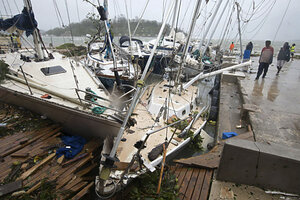Cyclone Pam: Why Japan is a leader in disaster relief
As the island nation of Vanuatu struggles in the wake of Cyclone Pam, global leaders are meeting in Japan for a U.N. conference on disaster prevention. Japan pledged $4 billion in disaster aid over the next four years.

n this image provided by UNICEF Pacific, people on a dock view yachts damaged in Port Vila, Vanuatu, Saturday, March 14, 2015, in the aftermath of Cyclone Pam. Winds from the extremely powerful cyclone that blew through the Pacific's Vanuatu archipelago are beginning to subside, revealing widespread destruction.
(AP Photo/UNICEF Pacific, Humans of Vanuatu)
Japan has pledged to provide $4 billion over the next four years to reduce the number and the suffering of disaster victims worldwide.
The Sendai Cooperation Initiative will include developing disaster-proof infrastructure, promoting global and regional collaboration, and training 40,000 government officials and local leaders – including a project focused on women’s leadership – to lower disaster risk and improve resilience after disasters, Japanese Prime Minister Shinzo Abe said Saturday at the third annual United Nations World Conference on Disaster Risk Reduction.
“Disaster risk reduction is the most important challenge for both developed and developing countries. For developing countries in particular,” Mr. Abe said, according to a press release from the conference in Sendai, Japan.
Japan's critical role in pushing progress on disaster risk reduction and management lies partly in own long history as an aid recipient and in coping with earthquakes and tsunamis, such as the recent tidal wave that struck the country’s Pacific coast in 2011, and the disaster at the Fukushima nuclear plant in 2013. Some have argued that while Japan is one of the world's largest financial aid donors, it falls short in supporting other nations in terms of trade, technology, and investment, as well as in providing security forces, promoting immigration, and improving the environment, reports the Economist.
But Japan's history in dealing with disasters has given it a “sensitivity and understanding in its engagement with other recipient countries that is based on first-hand experience,” according to the London-based Overseas Development Institute.
The East Asian nation has long been a leader in efforts to reduce disaster risk, having contributed about 27 percent of the world’s $13.5 billion total disaster risk reduction aid between 1991 and 2010, the Institute reported.
"Japan will contribute to the international community with our knowledge and technology," Mr. Abe said at the conference.
The announcement – and the conference – came as Cyclone Pam ripped through the island nation of Vanuatu in the South Pacific, destroying homes, cutting off power, water, and communication to the outer islands. At least eight people have been killed, with dozens more feared dead, according to reports.
“I am speaking with you today with a heart that is so heavy… our hope for prospering into the future has been shattered,” Vanuatu president Baldwin Lonsdale, who was at the conference, told the gathered leaders.
The disaster, which struck just before the conference opened, emphasized the need for global and regional solutions to the challenges of disaster risk reduction and management.
Some of those solutions involve recognizing women’s central role in disaster response and recovery. Despite some progress in empowering women to take charge during disasters, gender-based perceptions of women and girls as weak or inferior have isolated them from planning and decision-making processes, according to the UN Office for Disaster Risk Reduction.
“We realized that the people making decision for disaster preparations on day-to-day basis are mostly men,” Emiko Okuyama, mayor of Sendai, said in recalling the aftermath of the 2011 earthquake and tsunami that killed more than 200,000 people.
“It reminded us that women need to be part of every decision-making forum with regards to disaster risk reduction and be active leaders in the area,” she said.
Another solution, according to French Foreign Minister Laurent Fabius, lies in highlighting the link between climate change and severe weather events.
At Saturday’s conference, Mr. Fabius proposed the creation of a worldwide climate disaster warning system which would provide developing states, small island nations, and other vulnerable populations with access to real-time weather and climate updates via SMS alerts.
“It is necessary to tackle these problems together and not separately,” Fabius said.

